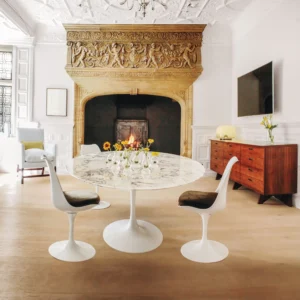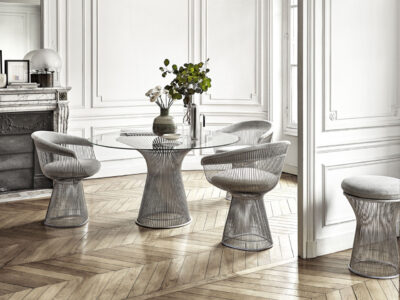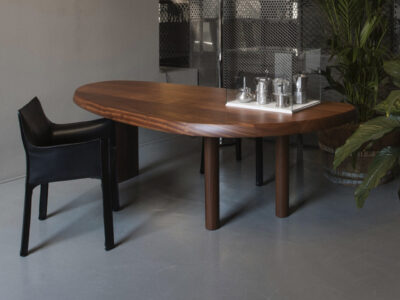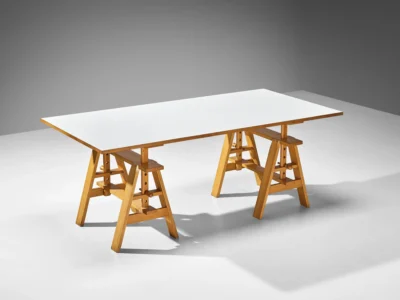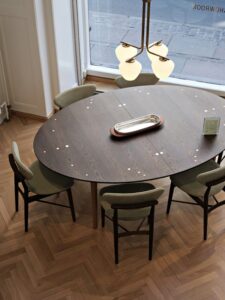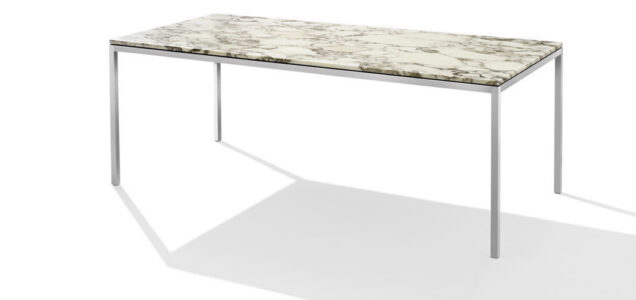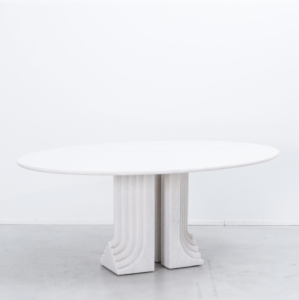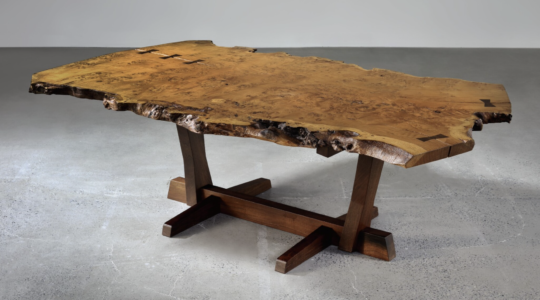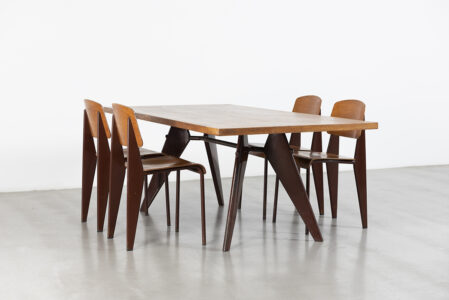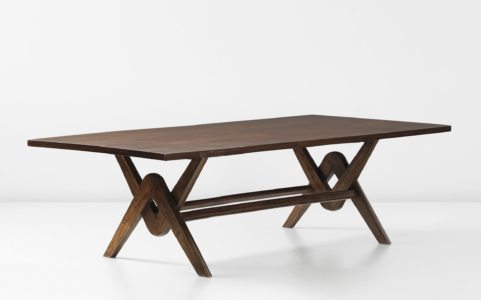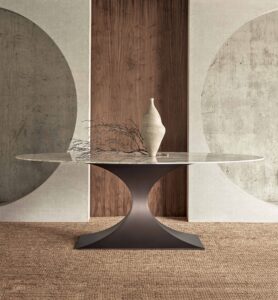When it comes to furniture, there’s nothing that sets the tone of a space quite like a dining table. It holds court in the centre of a room, creating a place to convene and connect. A dining table anchors its environment and directs how we behave within it. 20th century furniture designers knew this well and took it as an opportunity. For characters like Charlotte Perriand and Eero Saarinen, this was a chance to enhance the exchange between people and the objects with which they surround themselves. The modernist ethos swept in to reconfigure the basic form of the dining table and therefore, adjust how we approach that timeless ritual of sitting down over a meal. We’ve gathered a few of the finest examples of now iconic 20th century dining tables which have influenced Tom’s own creative process. We hope you’ll find them as inspiring as we do!
Tulip dining table by Eero Saarinen
Eero Saarinen’s ‘Tulip’ dining table has become a true icon of 20th century design. Its form is simple, streamlined, and smooth. He spent five years making it so, experimenting with ways to forgo the “slum of legs”, as he referred to it. He found the traditional four-legged configuration displeasing to the eye, especially when combined with a tangle of chairs. His solution was propping the tabletop up on an elegant pedestal. We may now have become more accustomed to this approach, but when Saarinen introduced it in 1958 it was heralded as the stuff of the future – and has since proven itself as such.
Platner dining table by Warren Platner
Warren Platner created his much-loved dining table in 1966 – though, one would be forgiven for mistaking it as a thoroughly contemporary design. Its form has a space-age quality about it, and the materials which comprise it are strikingly modern as well. The round dining table is built rod by rod, as each one is welded onto a circular frame. At the time of its introduction, this was pretty cutting-edge stuff. Today, it’s a canonical piece of modern design.
Table En Forme Libre by Charlotte Perriand
Charlotte Perriand is best remembered for her cool, glinting works of metal furniture. What’s less well documented are the amorphous wooden pieces she designed following an inspiring trip through Japan. This three-legged dining table is a fine example of her later style, designed in 1956. It’s a visual departure from the sleek and structured designs she started out with, but it keeps touch with her constant commitment to designing around the human body and its quotidian rhythms. The kidney-shaped table, also known as the ‘525’, offers a new and intriguing dynamic, clearing space for more seats, with each place flowing into the next. It’s an approach which has only been more enthusiastically embraced over the intervening years, solidifying the ‘Table En Forme Libre’ as a true design classic.
Leonardo table by Achille Castiglioni
There’s a deeply creative flavour to Achille Castiglioni’s ‘Leonardo’ table. This 1969 design would serve just as well as an architect’s desk as it would a dining table. The trestles beneath make it a mutable design, which is adjustable to five different heights. They also lend the piece a utilitarian aesthetic as well as a certain sense on honesty, with all its functional elements on full display.
Silver dining table by Finn Juhl
Finn Juhl is a master of Danish design, leaving various famous furniture pieces in his wake. His 1948 ‘Silver’ dining table starts with a simple oval form in dependable wood. He then elevates the design by including two leaves which allow the piece to be extended considerably. The icing on top comes in the form of thirty silver medallions, inlayed across the table’s surface. This spellbinding constellation is what gives the piece its familiar name, the ‘Judas’ table, alluding to the thirty silver pieces which are said to have been the price of Judas’ betrayal. When the leaves are inserted, that number increases to forty-two, with each cluster indicating a seating place. And so, Juhl leaves us with an artful and deeply original intermingling of form and function, which sits just as well in contemporary spaces as it did in mid-century homes.
Florence Knoll Dining Table by Florence Knoll
There’s a timeless quality to Florence Knoll’s work – and that’s certainly true of her 1961 dining table design. It’s crisp and clean with classic materials which have held their allure. In Knoll’s own words, it’s a “meat and potatoes” sort of design. “I did it because I needed the piece of furniture for a job and it wasn’t there, so I designed it”, she explained. Her use of cold materials like steel and marble, as well as the table’s rectilinear format, give it a strikingly sleek effect which works wonders in modern design schemes to this day.
Samo table by Carlo Scarpa
Carlo Scarpa was an architect first and a designer second. The two disciplines enriched one another, infusing all of his work with a sense of the sculptural as well as a stark strain of gravitas. In 1970 he designed the ‘Samo’ dining table with an architect’s structural eye and a designer’s knack for the finer details. The pedestal is reminiscent of a column, with its almost fluted format which recalls the gradations of a topographical map. As a native of Italy’s mountainous Veneto region, he would have been surrounded by this sort of visual vernacular. He cast his ideas in solid Naxos marble, turning away from the low-cost plastic and moulded fibreglass which many other 1970’s designers had fallen back on. The result is a modern design with staying power in a material tried and tested against the forces of time.
Conoid dining table by George Nakashima
George Nakashima brought a very human quality to modern design, looking to natural materials for a sense of warmth and character. His creations began as wonderfully wonky pieces of wood. He would allow the material itself to dictate the direction of his designs, being sure to showcase the idiosyncrasies which made each wooden form unique. This 1973 ‘Conoid’ dining table is an excellent example of the entrancing results which came from this process. Nakashima made the burled oak table top the star of the show, supporting it with an architectonic base of walnut. The piece comes together in a confluence of exacting craftsmanship and natural beauty, producing an enduringly resonant piece of modern design.
S.A.M. table by Jean Prouvé
Jean Prouvé has become a key figure in mid-century design, creating furniture with an industrial yet aesthetically finessed quality. His pedigree as an engineer shows through in his work, as he sought ways to redesign everyday objects in a smarter, more functionalist manner. The 1952 ‘S.A.M.’ table is a distillation of this approach, with hollowed metal legs which echo the formal qualities of his famous ‘Standard’ chair. Prouvé created the table for the French chemical company, Solvay, infusing it with a sense of its place and purpose as a utilitarian object in a busy workplace. It’s nonetheless a beautiful design object which has seamlessly made the jump to many considerately designed homes in the years since.
Committee table by Pierre Jeanneret & Le Corbusier
The ‘Committee’ table was a joint effort between cousins, Le Corbusier and Pierre Jeanneret. They created it in 1963 as part and parcel of their holistic design of Punjab’s new capital in Chandigarh. The table sat within the thoroughly modernist Palace of Assembly alongside countless now infamous designs, like the beloved ‘Chandigarh’ chair. There’s a common visual vernacular which ripples through the collection of designs, with motifs like the interlocking horns which comprise this table’s base cropping up time and again. The table takes form in two pieces, with the top section slotting neatly into the base below. There’s a simplicity and a deep sense of history to the table, which has cemented its place as a pivotal piece of modernist furniture.
Modernism in Motion
The modernist sensibility which produced these now iconic works of design continues to bear immeasurable influence today. Tom’s Capricorn dining table harnesses many elements of the 20th century approach to furniture design. It was born of a mixture between classical and modern principles. Symmetry, balance, and simplicity are key factors at work here, creating a design which has been a bestseller for over 25 years. It’s got a timeless quality which, we hope, puts it in good stead to sit amongst these iconic modern heirlooms.
Text by Annabel Colterjohn
